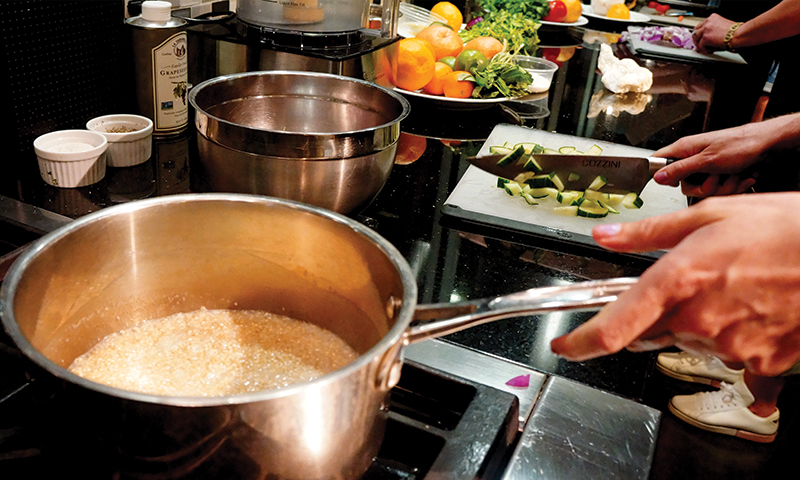
Harmons Hands-on Cooking Experience: The Harmons Cooking Class Program
Food: Interviews & Features
Harmons has been a prominent Utah purveyor of all things edible since 1932. In recent years, its 19 statewide locations have become more than merely a longstanding, local grocery store chain. The stores often architecturally and aesthetically reflect the immediate neighborhoods they’re built into. Seven of Harmons’ locations partner in a particularly pointed offering to the Utah foodie scene: the Harmons’ Cooking Class Program. From Mediterranean Mezze to French Macarons, the cooking series maintains a contemporary and culturally diverse offering of instructional classes. Our time in the stylish Harmons test kitchen at their massive City Creek flagship store felt like more of an edible experience than a mere educational endeavor, lending to the appeal of the program. A beautifully appointed, open and modern kitchen surrounding a large stainless-steel dining array sets the scene for our courses.
The program began at the Bangerter Crossing store in 2008 as part of a brand-wide revision process, wherein the historic local business modernized and expanded. Vice President of Marketing and Advertising Lindee Nance says, “Incorporating culinary education gave us an opportunity to directly connect with the public about the great work our chefs were doing, as well as to teach about new ingredients and food trends that we wanted to bring to Utah from around the world!” Since its inception, the cooking class has transformed into a multiform cultural touchstone for the community, with each store and each instructor bringing unique flavor and flare that shifts by seasons and culinary trends. The program’s design clearly reflects a level of consideration for the needs of each store’s surrounding communities as well as foodie demands on a national and international level.
“Incorporating culinary education gave us an opportunity to directly connect with the public about the great work our chefs were doing.”
“Our cooking school chefs all bring a great deal of education and experience to the table—literally. They also create their own course curriculum. Each school has autonomy to create the classes its specific community wants and is asking for,” says Nance. That highly personal touch comes with the occasional snag. She says, “The biggest challenge is staying up to date on what’s trending in food before it even hits our market.”
The class is initiated with ice-breaking chatter, fresh seasonal décor, floral arrangements and refreshments, including a personalized wine-and-beverage service. The course reads as a clever and acculturated way to spend a weekend evening or a midweek date night. Attendees are regaled with accommodating group tutalage including dual overhead screens displaying an aerial view of the cooking surfaces for full immersion in the process. Instructors provide a step-by-step walk through before releasing the attendees to the assortment of state-of-the-art stove tops in order to reproduce the highlighted recipes of the evening. Their efforts make for a holistic learning adventure into the scientific and gustatory. The courses are reasonably comprehensive yet friendly to all levels of experience, with most ingredients pre-measured and prepped by staff.
“The biggest challenge is staying up to date on what’s trending in food before it even hits our market.”
At the time of our visit, the Mediterranean Mezze course was taught by staff dietician Genevieve Daly, a veteran nutrition pro and first-time cooking class instructor. The class was a two-course overview of classic and infusion dishes including a quinoa tabbouleh, seared scallops over a harissa-carrot purée and a lightly sweet citrus dessert salad. Attendees observed the process of each dish, then were sent into breakout triads to recreate the menu with instructor support. The aroma of freshly ground basil infused the air as attendees chopped, cubed and seared their way through the menu. With the exception of stubbornly sticky scallops, the dishes were reasonably easy to recreate. As with many of the classes, members enjoy the fruits of their labor in the third act, where they join once more at the dining table to consume the meal they’ve curated as a collective. One of the less marketed joys of the course is the social interaction around the table, a rich opportunity to connect with friends and new acquaintances alike, and a lovely finish to the meal, no matter if the edible outcome suits your palate.
Harmons staffs several full-time dietitians who serve a couple of store sites every week. “We do a lot of programing—like yoga and smoothies—and encouraging and offering more healthy classes is awesome. Showing that healthy food can taste good is my mission,” says Daly. Daly and her nutritionist cohort provide monthly classes, onsite nutrition counseling services and free store tours for diabetics, gluten-free patrons and more. They also educate the Harmons staff, providing recipes, blogs and nutritional-education services for associates and customers alike. Harmons’ dedicated cooking course staff are an eclectic array of personalities and skillsets under the supervision of head chef Evan Francois. Including Francois, nine chefs staff the Harmons roster. Each bring a unique experience to the program, enhancing the eclectic and broad spectrum of options for refining one’s culinary chops.
“Showing that healthy food can taste good is my mission.”
As the growing offerings of the program emerge, Nance says, “We’ve announced our 20th store location, which will also be home to Harmons’ 8th cooking school: North Short Market in Daybreak … Expect it to be opening fall of 2020!” One might consider making something of a hobby from attending these courses. Harmons offers undoubtedly one of the richest and most esculent options for food lovers of all types: Learn more about upcoming classes and locations at harmonsgrocery.com/classes.
More on SLUGMag.com:
Cheese-and-Beer Pairings via Harmons
Discover Food Festival @ Traeger Grills 06.07
